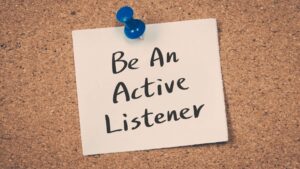
“WAIT. What Did the Leader Say?” ~Dr. June Hall, Speaking Foundation, drjuneaptacious@gmail.com
Are you in a leadership position? Do you have a message? Is it very important? Of course it is, but when no one is listening the value of the message is lost. Effective Communication needed. Sure, we’ve heard it all before. It’s a commonly used phrase. Check out many of the job descriptions. That’s right you’ve read it, “good communication skills” needed. You probably even have it listed on your resume, “excellent communication skills”. What do we even suggest by that? That we speak well or are a good presenter? While that is awesome, let’s delve even further into what effective communication really means. Effective is being successful in what you’re trying to accomplish, and communication is simply sharing information. Easy. We’re successful in sharing information. Then why is it so hard to be understood and make it meaningful? Being that’s the tricky part, let’s see if we can break it down even further and get the communication process flowing.
The initial part of the problem would be the words. Less than 10% of what you say is part of the listening process. While we’re saying the words, people are looking more at our expressions and body language, which means what we’re expressing has to show in how we’re expressing it. The other part is overload. Most people are communicating with others throughout the day but only approximately 50% are really listening. This could be due to feeling overwhelmed at times, especially relating to work situations, and that’s an uphill battle. So now what? What do you do to get your coworkers, students, staff or others to not only hear, but really listen to what we are trying to convey? I hear you! I get it! I acknowledge you! These are three ways to improve our communication skills.
I hear you! Many times in communicating with others, we are so busy waiting to respond that we miss the entire message. We hear something initially and are ready to share without focusing on the rest of what is being said.
Be an “active” listener and then others will want to listen to you as well.
Active means you are engaged in what the person is saying. That includes eye contact, nodding, shaking your head if you don’t understand, facial expressions and body language that connects with the message. If we think about it, why would anyone want to listen to someone who doesn’t show interest in listening and in having a two-way conversation. One-sided conversations are dismissive and unacceptable. “I hear you” will strengthen our communication because you are willing to hear what is said in its entirety rather than in parts. Have we missed our chance to get better? No, it’s not too late to begin the listening process. Of course, we have to do this outside of speaking at meetings or dealing with touchy situations with staff members. Start now by incorporating these two other helpful components.
I get it! Now we’re getting it. Hopefully! In other words, we not only “hear” the words, we “understand” the words. Have you ever just said “okay” even though you didn’t quite know what was being said? At times we heard the words but maybe the comprehension wasn’t clear. That’s when we ask a question to get clarification. To ask a question so that the message is clear is actually a positive part of the communication process. Misunderstanding can lead to frustration and sometimes even conflict. Let’s avoid that.
In addition to asking a question, we can use our own words to repeat what was said. In counseling there is something called reflection. This is paraphrasing what was said to let whoever is talking know “I get it”. Also, in offering words back for clarity, our tone and expression shows we understand. Now we’ve shared that we heard the content, responded with the right emotions, and expressed that what has been said is understood. Of course, every conversation is not based on some emotion, but knowing when we need to show understanding of someone’s feelings will only strengthen our ability to relate and communicate better.
I acknowledge you! Acknowledgement is very high on the Effective Communication scale. Here, we are showing there is value in what we have heard. As a leader, our staff and students want to be recognized. When there is a concern, express understanding of that concern as well as recognize there is value in what is being shared. Even if there is nothing that can be done, offering feedback with an explanation could also be helpful.
Three ways to offer feedback are to respond with transparency, be sincere, and ensure the importance of the listening audience.
Transparency. Clarify you know the importance of what was said and as a leader be honest with the response. For example, I hear what you’re saying and know where you’re coming from to add healthier items in the café and toilet seat covers for the bathroom. At this time, though, we are putting finances into more staff and don’t have the budget.
Show sincerity. Family is important. I sometimes feel guilty for not spending enough time with them. Hopefully, all will work out well with your situation. Keep me posted.
I acknowledge you! As staff, students, human beings, you are important! I appreciate what you do and what you offer is valuable and not taken for granted.
Now we have created support and a reason to listen. That is the bottom line. Actively listen, be understanding, and acknowledge the importance of the audience. In return, our audience now has more positive responses. They want to hear what these leaders, individuals, department heads, etc. have to say because they listen and show genuine interest. And there you have it… the communication process.
SPRING 2023 (CLT) CAMPUS LIFE TRENDS MAGAZINE